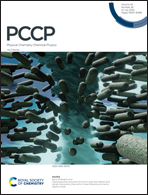Topology detection in cavity QED†
Abstract
We explore the physics of topological lattice models immersed in c-QED architectures for arbitrary coupling strength with the photon field. We propose the use of the cavity transmission as a topological marker and study its behaviour. For this, we develop an approach combining the input–output formalism with a Mean-Field plus fluctuations description of the setup. We illustrate our results with the specific case of a fermionic Su–Schrieffer–Heeger (SSH) chain coupled to a single-mode cavity. Our findings confirm that the cavity can indeed act as a quantum sensor for topological phases, where the initial state preparation plays a crucial role. Additionally, we discuss the persistence of topological features when the coupling strength increases, in terms of an effective Hamiltonian, and calculate the entanglement entropy. Our approach can be applied to other fermionic systems, opening a route to the characterization of their topological properties in terms of experimental observables.

- This article is part of the themed collection: New Trends and Challenges in Surface Phenomena, Carbon Nanostructures and Helium Droplets


 Please wait while we load your content...
Please wait while we load your content...